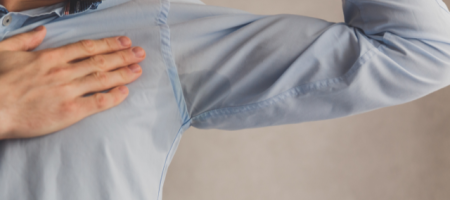Hyperhidrosis

Hyperhidrosis is excessive sweating and be localised to one body site, e.g., palms, or generalised, affecting the whole body.
The main types of hyperhidrosis are:
- Axillary (sweaty underarms)
- Palmar (sweaty hands)
- Plantar (sweaty feet)
- Compensatory (rebound sweating)
Symptoms
Hyperhidrosis can be localised or generalised.
Localised hyperhidrosis affects armpits, palms, soles, face, or other sites while generalised hyperhidrosis affects most or all the body.
HS is characterised clinically by:
- Open double-headed comedones
- Painful firm papules and nodules
- Pustules, fluctuant pseudocysts, and abscesses
- Draining sinuses linking inflammatory lesions
- Hypertrophic and atrophic scars.
Causes
There are two types of hyperhidrosis; primary and secondary
Primary hyperhidrosis:
- Starts in childhood or adolescence
- May persist lifelong or improve with age
- There may be a family history
- Tends to involve armpits, palms and or soles symmetrically
- Usually, sweating reduces at night and disappears during sleep.
Secondary hyperhidrosis:
- Less common than primary hyperhidrosis
- More likely to be unilateral and asymmetrical, or generalised
- Can occur at night or during sleep.
- Due to endocrine or neurological conditions or drugs.
Treatments
Treatment include:
- Topical treatments
- Botulinum toxin injections
- Oral medication
- Iontophoresis
- Endoscopic thoracic surgery
- miraDry
Resources
For further information, you can visit the following resources:

